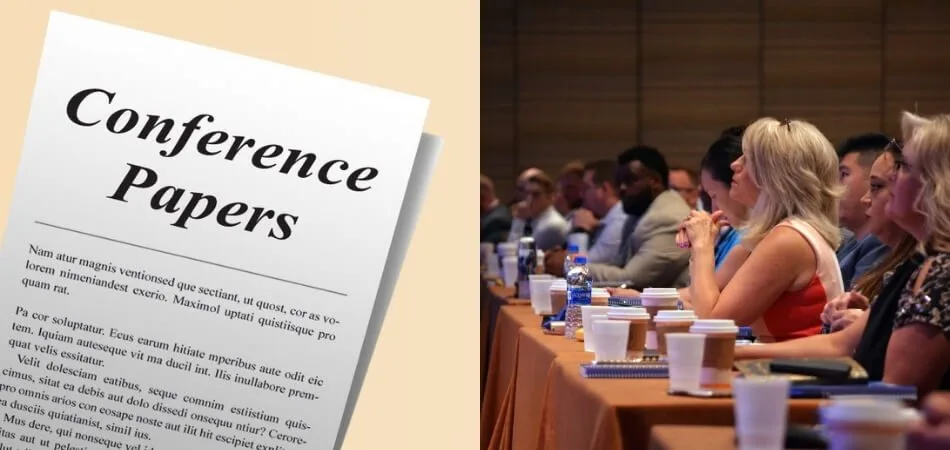Conference papers are a crucial component in the area of academic research, often sparking curiosity about their credibility as scholarly sources. So, is a conference paper a scholarly source?”
Yes, a conference paper is a scholarly source. These papers present original research or findings and are usually subjected to a rigorous peer-review process. By being shared within the academic community at various conferences, they significantly contribute to the expansion and evolution of knowledge in their respective fields.
This article invites you to dive further into the role and importance of conference papers in scholarly communication, providing a deeper understanding of their place in academia.
What is a Scholarly Source?
A scholarly source is typically a document or publication created by experts in a specific field. These sources are intended for an academic or professional audience, characterized by detailed research and analysis. They often include extensive references to support their findings and arguments.
Unlike popular sources, scholarly materials go through a rigorous peer-review process before publication. This ensures the accuracy, reliability, and academic integrity of the content. The purpose of these sources is to contribute new knowledge, theories, or insights to a particular discipline.
Scholarly sources vary in form, including journal articles, conference papers, and books. They’re essential for academic research, providing in-depth information and critical perspectives. Relying on such sources ensures that research is grounded in credible and authoritative information.
What is a Conference Paper?
A conference paper is a form of academic writing presented at professional gatherings or symposia. It typically explores new research findings or theoretical developments in a specific field. Authors use these papers to share and discuss their work with peers for feedback and collaboration.
These papers are often short, focusing on key aspects of a research project or study. Before the presentation, they usually go through a selection process by a committee of experts. This ensures that the content is relevant, and original, and contributes to the field’s knowledge base.
After the conference, many papers are published in academic journals or conference proceedings. This publication process often involves additional peer review, enhancing the paper’s credibility. Consequently, conference papers are valuable resources for researchers and professionals seeking advanced information.
Is a Conference Paper a Scholarly Source?
Yes, a conference paper is indeed a scholarly source. It represents original research or new findings within a specialized field. These papers are integral to academic discourse, contributing significantly to the collective knowledge in their respective areas.
Originality and Innovation
Conference papers often introduce groundbreaking ideas or advancements in research. They provide fresh perspectives or solutions to existing problems in their field. This originality is a hallmark of their scholarly value. Authors are usually experts or researchers deeply engaged with their subjects.
Peer Review Process
Before being accepted for a conference, these papers typically go through a careful peer-review process. This inspection by other experts ensures the quality and accuracy of the information presented. The peer-review process also helps in refining and improving the content. It’s a key factor in establishing the paper’s scholarly credibility.
Academic Contribution
Conference papers contribute to the ongoing dialogue in their field of study. They are often the first public presentation of new research findings. These contributions are crucial for the advancement of knowledge and academic research. They often lead to further studies and publications in academic journals.
Publication and Accessibility
After the presentation, many conference papers are published in academic journals or proceedings. This publication extends its reach beyond the conference, making it accessible to a wider academic audience. The accessibility of these papers enhances their impact and utility in academic research.
How to Utilize Conference Papers as Scholarly Sources?
Conference papers can be a treasure trove of up-to-date and specialized information for researchers and academics. To effectively utilize them as scholarly sources, one must approach them methodically. Here’s a step-by-step process of how to utilize conference papers as scholarly sources.
Step 1: Identifying Relevant Conferences
Begin by pinpointing conferences that are renowned in your research area. These gatherings are where experts discuss recent advances and ideas. Researching the conference’s reputation and the quality of past papers can guide you to credible and influential sources.
Step 2: Accessing Conference Proceedings
After pinpointing the right conferences, seek out their proceedings. These collections contain all the papers presented and are often accessible through academic databases or university libraries. Digital libraries or conference websites can also be valuable resources for accessing these papers.
Step 3: Evaluating the Paper’s Relevance
Carefully read through the papers to determine their relevance to your topic. Focus on the abstract, introduction, and conclusion for a quick assessment of their applicability. This step is crucial in filtering out papers that are most pertinent to your research needs.
Step 4: Assessing the Quality
Assess each paper for its research quality. Investigate the authors’ credentials, the rigor of their methodology, and the depth of their analysis. Peer-reviewed conference papers are typically more reliable and hold greater scholarly value.
Step 5: Analyzing the Findings
Thoroughly analyze the content of the paper. Understand how the findings contribute to the field, and consider the methodologies used. This deep analysis helps in drawing valuable insights and understanding the nuances of the topic.
Step 6: Noting References and Citations
Examine the references and citations within the paper. They can lead you to additional primary and secondary sources, providing a broader context for the research. This can be instrumental in building a comprehensive literature review for your study.
Step 7: Applying the Insights
Incorporate the insights gained from the conference paper into your research. Utilize the findings to support your hypotheses, contrast them with other viewpoints, or identify new areas for investigation. This integration enriches your research and demonstrates a thorough understanding of the subject matter.
Pros and Cons of Using Conference Papers as Scholarly Sources
Conference papers are valuable but sometimes overlooked resources in academic research. They offer a glimpse into the cutting-edge developments within a field but also come with certain limitations. Here’s a view of the pros and cons of using conference papers as scholarly sources.
Pros
- Provide the most recent research, often presenting findings that are more current than those in journal articles.
- Showcase the latest trends and methodologies, offering a window into evolving practices and theories in a particular field.
- Typically go through a peer-review process by experts, adding a layer of credibility and scholarly integrity.
- Encourage interdisciplinary work, bringing together various perspectives and fostering innovative research collaborations.
- Act as a platform for presenting preliminary findings and untested ideas, encouraging academic debate and discussion.
- Are more readily accessible, often available in digital formats, making them easier to obtain than some journal articles.
- Indicate future research directions, offering insights into where a field is heading and the evolving interests of researchers.
Cons
- May lack the in-depth vetting process of journal articles, raising questions about their thoroughness and accuracy.
- Generally do not undergo as rigorous a review process as journal articles, potentially affecting their reliability.
- Often focus on niche or highly specific topics, which may limit their applicability to broader research questions.
- Tend to be shorter and less formal than journal articles, possibly lacking comprehensive detail and analysis.
- Might have a narrower distribution, usually within conference attendees and specific academic circles, unlike widely circulated journals.
Conclusion
In academic research, conference papers stand out as valuable sources of novel insights and findings. Their role in presenting original research and fostering academic dialogue is undeniable.
Addressing the query is a conference paper a scholarly source, affirms their status as possible and significant contributions to scholarly communication. They are not only peer-reviewed but also serve as platforms for emerging ideas and interdisciplinary collaboration.
However, It’s critical to study these sources with an awareness of their limitations, including their occasionally limited scope and informal structure. Balancing their innovative content with a critical evaluation is key to effectively utilizing them in academic research.








